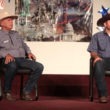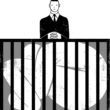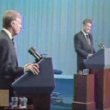Democratic senator Jeff Bingaman of New Mexico and Patrick Leahy of Vermont are making a big statement with a small bill. In the House, California Democrat Henry Waxman already has. It’s an amendment to the Presidential Records Act. If it passes the Senate, this will be another sign that the Congress is reasserting its constitutional authority as a co-equal branch of government.
In thirteen days Waxman, a man in a hurry to repair the damage the recumbent Republican Congress allowed the Bush-Cheney administration to do to the architecture of the Constitution between 2001 and 2007, moved the bill out of his committee and through the House by a 333-93 vote, which included 104 Republican yeas. Bingaman’s Senate version has been introduced and referred to committee.
The White House has threatened a veto of this revision of the Presidential Records Act, in itself remarkable because the president has vetoed only two pieces of legislation in six years: a bill funding stem-cell research and another one (just recently) restricting funding of the war in Iraq. When the PRA amendment reaches the floor, it will require senators to place their institutional patriotism above their loyalty to Bush.
The bill would override a Bush executive order that gives ex-presidents and their heirs veto power over the release of White House papers and even allows sitting presidents to block the release of records of presidents who held office before them. It has two Republican co-sponsors. John Sununu of New Hampshire is no surprise. Texas Republican John Cornyn would seem an unlikely candidate to stand up to the president if Cornyn hadn’t bucked George W. Bush (and Karl Rove) back when Bush was the governor of Texas.
The restrictions President Bush imposed on executive records in Washington in 2001 had, in fact, been rehearsed in Austin. In December of 2000, shortly after the Supreme Court had declared Bush the 43rd president of the United States, he had his papers boxed, shrink-wrapped, loaded onto pallets, and trucked eastward to his father’s presidential library at Texas A&M University.
The groundwork for this paper shuffle had been laid during Bush’s first term as governor, while Alberto Gonzales was his general counsel and Bush had quietly signed a law allowing Texas governors to bypass the state’s Library and Archives Commission and designate on their own a repository for their papers. Just before he resigned as governor, Bush had moved his papers beyond the reach of the Texas Open Records Act into a gray area that might have allowed for years of cataloguing and archival dithering. The deal was lawyered by Gonzales, who was leaving the Texas Supreme Court to become White House counsel.
The unlikely hero of this tale was Texas Attorney General John Cornyn. Like Bush and Gonzales, Cornyn was a creation of Karl Rove, who had directed his successful campaigns for a position on the state Supreme Court and as Texas Attorney General. Unlike Bush and Gonzales, though, Cornyn has an almost perverse dedication to open records. When reporters complained that Bush had violated the law by moving his papers to his father’s library, Cornyn agreed. He issued a legal opinion and negotiated a memorandum of understanding that made all of Bush’s papers subject to the ten-day response time written into the Texas Open Records Act.
NIXON’S SHADOW—The passage of Senate Bill 886 won’t end the war in Iraq. Nor will it ensure that the current administration doesn’t bomb Iran—still the subject of an ongoing internal debate. But it does address the unconstitutional expansion of executive power that has defined this administration. And its backstory illustrates that Alberto Gonzales’s canine fidelity to George W. Bush extends to their time together in Texas, when Karl Rove saw Gonzales as a Latino Pygmalion who would add some color to an overwhelmingly white Texas Republican Party.
Four years later, Congress passed a comprehensive law, the Presidential Records Act, which made the papers of all former presidents the property of the people. Under it, presidents could archive their papers in presidential libraries, but the papers would remain under the control of federal archivists. The same law provided exemptions for national-security documents, and a process for ex-presidents to review their “P-5” documents, which include confidential communications between the president and senior advisers.The bill now moving through the Senate aims to undo Executive Order 13233, which Bush signed a month after 9/11. In doing so, Bush undid one of the post-Watergate changes enacted by Democratic reformers elected to Congress after Richard Nixon resigned. With his presidency crumbling under the weight of the Watergate scandal, Nixon had claimed that his tapes and other White House documents were private property that he could keep or even destroy. The Supreme Court disagreed. So did the Congress, which passed a 1974 law that declared Nixon’s papers public property, to be archived in Washington.
ONE FOR THE GIPPER—Under the Presidential Records Act of 1978, archivists begin releasing presidential documents five years after a president leaves office. An ex-president can order archivists to hold his P-5 documents. But at the end of twelve years, all documents not related to classified national security matters must be released to the public. Ronald Reagan’s twelve-year hold expired on January 20, 2001. On the day George W. Bush took his presidential oath of office, 68,000 pages of Ronald Reagan’s presidential records were scheduled by law for release.
Al Gonzales said no. In January 2001, Gonzales and his staff recapitulated what he had done a month earlier in Texas, blocking the release of records that by law belonged to the public. Invoking the 90-day period an incumbent president is allowed to review the papers of a former president, Gonzales said his office needed time to review the documents and consider the “many constitutional and legal questions” they evoked.
Gonzales kept the Reagan files tied up with a series of 90-day extensions until November 2001, when President Bush signed Executive Order 13233. It drastically slowed the release of Reagan’s P-5 documents—and in theory the records of every president who followed Reagan, the first president to whom the 1978 law applied.
“With a stroke of the pen on November 1, President Bush stabbed history in the back and blocked Americans’ right to know how presidents make decisions,” wrote Richard Reeves, who had written biographies of John Kennedy and Richard Nixon.
Bush’s critics claimed the president was running interference to protect his father and members of his own administration. The senior Bush had served as Ronald Reagan’s vice president and famously claimed that he’d been “out of the loop” during the Iran-Contra scandal, in which members of the Reagan administration broke the law by providing covert military aid to Nicaraguan insurgents engaged in terrorist acts that included mining their country’s harbors. The Reagan papers also included documents related to Reagan administration officials serving in the Bush II administration: Dick Cheney, Colin Powell, Paul Wolfowitz, Condoleezza Rice. As things turned out, the Iran-Contra suspicions would prove to be a dead end. Because the operation was illegal and “off the books,” critical memoranda were run through shredders or spirited out of the executive office in the bra of Fawn Hall, Col. Oliver North’s personal secretary.
HIGH-OCTANE LEGAL TEAM—Al Gonzales didn’t do the heavy lifting on the plan to control the release of the Reagan records. And there was more to it than the mugging of history described by Reeves. The legal thinking was done by Brett Kavanaugh, a deputy White House counsel working under Gonzales. Also involved was David Addington, at the time Vice President Dick Cheney’s legal counsel and currently Cheney’s chief of staff. The collaboration of two ideological lawyers shutting down access to presidential records in the earliest days of the Bush administration recalls Hillary Clinton’s claim about “a vast right-wing conspiracy.”
Kavanaugh, in fact, was part of that conspiracy. A member of the Federalist Society, a powerful association of right-wing lawyers, he worked with Independent Counsel Kenneth Starr on the Whitewater investigation. Starr assigned him to write the near-pornographic passages that described Clinton’s sexual encounters with White House intern Monica Lewinsky, intended to humiliate Clinton.
Kavanaugh was more than a staff writer. He argued before the United States Supreme Court that notes and memoranda regarding confidential discussions Clinton aide Vince Foster had with his attorney shortly before Foster’s suicide should be made public. Kavanaugh and Kenneth Starr were willing to overturn the principle that attorney-client privilege remained valid even after the death of the client, a protection that originated in the courts of Elizabethan England.
What’s noteworthy about this subplot in the larger Whitewater drama is that its prosecutors were willing to dispose of one of the oldest principles of Anglo-Saxon jurisprudence to get to the bottom of the firings in the White House Travel Office—the small matter underlying Kavanaugh’s bold argument before the court. Then, less than two years after he tried to convince the Supreme Court that the most private of legal affairs should be made public, he was writing legal opinions that would in effect keep presidential records private. (He’s now a Bush appointee to the federal bench.)
Kavanaugh was working with the extraordinarily talented Addington, whose long association with Dick Cheney began while Cheney was on the House Intelligence Committee, where Addington was a member of the legal staff on the minority side. Addington and Cheney worked together on the joint House-Senate committee investigating the Iran-Contra scandal, and Addington was Cheney’s Chief of Staff at the Pentagon. He has been Cheney’s legal thinker and strategist, shares his authoritarian philosophy of government, and is one of the principal proponents of the unitary executive—a right-wing vision of an American presidency in possession of far more authority than anything ever envisioned by the framers of the Constitution.
Alberto Gonzales is not an ideologue. Nor is he a legal theorist. More of a legal apparatchik, he is willing to let the big thinkers do the big thinking. And the big thinkers in the Bush-Cheney administration spend much of their time thinking about the unitary executive and how to implement it; which explains how a lawyer who once tried to abrogate the attorney-client privilege of a dead man could convince Gonzales that honoring the executive privilege of a dead president is good law.
TURNING BACK THE CLOCK—Considered in a larger context, George Bush’s attempt to control the records of a president who had been out of office for twelve years (and was so mentally incapacitated that he couldn’t make decisions) was one of many moves calculated to expand executive power in a step toward the unitary executive envisioned by Cheney, Addington, John Woo and Donald Rumsfeld.
Tom Blanton is the director of the non-profit National Security Archive, at George Washington University. He is one of several plaintiffs in a lawsuit challenging Bush’s executive order on the subject of presidential records. In testimony before a House committee in March of this year, Blanton defined what lies behind the president’s decision to deter the release of the Reagan papers: “The administration’s top lawyers asked only one question about implementation of the Presidential Records Act, and the question was how to increase presidential power over that implementation.”
To support his argument, Blanton quoted Dick Cheney defending his decision to withhold from Congress the names of lobbyists who met with his Energy Task Force in the spring of 2001: “Vice President Cheney began by saying that withholding the information was where ‘the lawyers decided’ to draw the line but went on to cite ‘an erosion of the powers and the ability of the President of the United States to do his job’ because of ‘unwise compromises made over the last thirty or thirty-five years.'”
In an interview, Blanton returned to a discussion we had in Washington a year earlier when I was working on a book about Dick Cheney. “The core narrative tying together the Bush-Cheney decisions across the board is That Seventies Show,” Blanton said. “They are essentially going to take back whatever the American people and the Congress and the courts took away from the presidency in the 1970s. Every law passed in the 1970s that limited presidential power, that’s the starting point for Bush and Cheney. That’s the core narrative.” The Bush administration, Blanton observed, opposes the Freedom of Information Act, the Foreign Intelligence Surveillance Act, the War Powers Act, the Government Accountability Statute—all of them enacted in the seventies to impose limits on the powers of the president.
Donald Rumsfeld brought Dick Cheney into the Nixon administration. Both Cheney and Rumsfeld served as chief of staff to President Gerald Ford, both witnessed Ford order the evacuation of Saigon. Both men were disturbed by the post-Watergate reforms Congress enacted in the ’70s. The current Bush administration was their second rendezvous with destiny, and this time they were determined to get it right. The Bush-Cheney administration is, on one level, a crusade to return to the imperial presidency that began with Roosevelt and ended with Nixon.
The American Historical Association, the National Security Archive, Public Citizen and others have filed suit challenging the executive order—which as interpreted by the White House legal staff allows a former president to delay indefinitely the release of his White House records and allows an incumbent president to delay the release of his predecessors’ papers. Most remarkably, according to the order an ex-president can designate a family member or legal trustee to decide on the release of documents in the event of physical or mental incapacitation or death, keeping presidential records in a literal mortmain. Such provisions hold enormous appeal for Bush and Cheney, whose obsession with secrecy can now extend to the grave.
Anna Nelson is a scholar who served on the commission that in 1977 helped create the Presidential Records Act. She testified before a House committee shortly after Bush issued his 2001 order. She had done the math and concluded that in the year 2050 a president could be sitting in review of the release of the records of the current Bush administration. As could George and Laura Bush’s daughters. The twins will be turning sixty-nine in November of 2050.
It will be worth watching to see if the president is willing to invest any of his diminished political capital in a veto of a six-page bill that, on its face, pertains to archival housekeeping. And if the Waxman-Bingaman bill doesn’t become law, Barbara and Jenna may someday be sitting in the manse at Kennebunkport, two sober sexagenarian heirs to their father’s executive privilege, blocking the release of memos Al Gonzales wrote to George Bush four decades earlier.





0 Comments